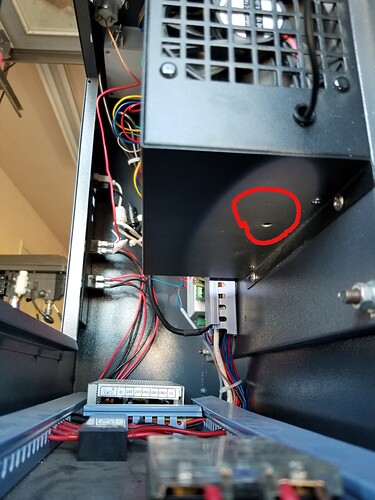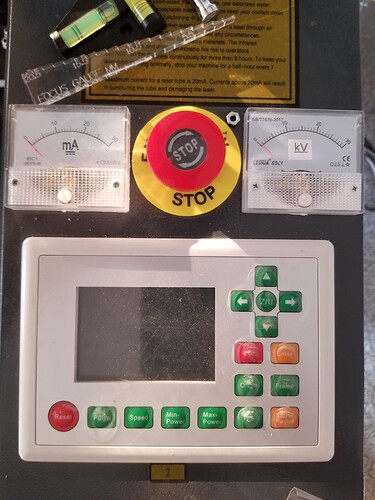I have an 150w power supply and i want to replace the tube with an 100w tube. If i adjust the power and find the correct spot to not pass 28mA, is it going to work? I am asking because the ignition voltage is different
Yes, it will work. The PSU must always be larger than the tube voltage wise. Other way around and the PSU will cook itself trying to supply what the tube needs. With the 150W - 100W gap, you may lose a little of the bottom end detail, but everything else should work just fine.
Thanks for replying. My concern is the ignition voltage no ton burn the 100w tube as 150w PSU has more voltage. Also what do you mean i will lose some bottom end detail?
Ignition threshold is determined by the tube, not the PSU. You will be able to get work done at a lower power percentage with the 100W tube.
By bottom end difference, I’m talking about the controller / PSU interface. Primarily how fine a detail you can get in power percentages. A 1% jump in power for a 150W PSU is a lot larger than a 1% jump in a 100W PSU. But since you’ve been using the 150W all along, you should have it pretty much down. Come to think of it, because you are making the opposite swap that most are trying to make, you may see more differences in your top end than the bottom.
At the very minimum I would run a new set of material power tests. Personally I’d run a complete power test and generate a new power curve, but most users don’t know how or have a calorimeter of any sort to actually do it. It’s not something manufacturers put forward as it can show how piss poor some of their tubes are. It would also tell you exactly where you hit your 100W mark.
Very interesting the power test you are mentioning. Is there a guide tha explains the procedure?
Basically i bought the machine used. It has a burned 130w tube. The 150w PSU is supposed to work. But i dont have a way to test it. That’s my other question. Is there a way to test the PSU without tube? I’ve seen some video using a big ceramic resistor amd mA gauge like dummy load. They measure the mA like it was tube.
If i clarify that the PSU works i will buy an 130w tube with same PSU. If it’s burned i will buy a complete new set of 100w
No idea on the testing of the PSU with a dummy load. Not something I would ant to mess with with that much voltage.
For power testing / power curve, take a look at Russ’ videos. My notes say it’s #53. Basically you take measurements at every 5% increment five times. Throw out the high and low and average the remaining three for each test percentage. Drop them in a spread sheet and it will produce a graph, or at least Excel will. My POS factory tube has a power curve that looks more like a quarter circle, so I went back and did a 2% jump for the bottom and top end. With a curve like that, a minor change at the bottom end gave a major jump in output, but took a major change at the top to get even a 1/2W change.
And remember, the power percentage on your display is a fantasy number. It’s the product of the tube, the PSU, and the controller. Change any one of them and your percentages WILL change. Usually only a few percent, but they will change. I’ve changed controller and PSU, and had a rough 3% change each time.
Thank you very much Dave! I will check the videos you advised me. Hopefully I’ll figure out the tests ![]()
I wil probably then go for 130w and take the risk that the psu works
Like I said, as long as the PSU is larger than the tube, you’re good. And don’t go just by the name plate rating. My ‘80W’ PSU will actually power a quality SPT 90W tube by the voltage requirements. Not all tubes, but some. The PSU’s are a bit under rated by the label wattage to allow for the higher voltage requirements of the poor quality tubes.
I think they burned the tube because they didn’t have any mA gauge, and probably they were working it at limits. Definitely not calibrated the power supply. Also the water pump was much used so if they were cooling it with just a pump… one more reason to burn. Normally the PSU will work i think
Yeah, I almost lost a tube to a bad in line flow switch and a weak pump the switch failed to contact regardless of the flow. Didn’t help the QC reject tube has nasty glass work. Even with a strong pump I don’t get much over minimum coolant flow. Switching to a pressure switch instead of a flow switch gained me .5 gpm thought. Just enough of a cushion to make me happy.
I will use a CW5200 for 100 or 130w to be sure it cools the best possible ![]()
If you get a new tube, make sure you get a brand name that has good flow. That was part of the QC reject that I got with my new machine, bad glass work so bad the thing barely had enough flow to keep the tube cool.
FYI, Not all 5200’s have a heat option if you are in a cooler climate. I had to add one to my 5200 to keep everything from freezing.
Larger tubes require a higher voltage to start lasing. The response time of a 150W supply and a 50W supply are usually placarded with the same 90% of placard voltage in <= 0.1mS. So the 150W supply has to produce a higher voltage quicker to meet the same criteria. This translates to a quicker response time with a smaller tube…
Even if you don’t it will probably work… however how exactly do you ‘adjust the power’?
With a large lps you really need to adjust it internally. Should do this anyway, I’m pretty convinced the factory doesn’t even check.
@Dave01 gets down in the teens here in the winter. I used to run 50% Propylene Glycol… I’ve switched over to the OMTech laser coolant…
If I lived in the EU, I’d probably go with this type, as it’s a mixture that is non toxic…
I’ve also got a variant, 5202 chiller…
Is tube coolant related to the question?
![]()
Basically i live in South Europe and the machine is in a shop. So temperature is not going to be under 7-8 Celsius even in deep Winter. So i dont think i need an antifreeze cooland.
Internally you mean with the potiensometer supposed to be somewhere in the PSU?
Some laser PSU’s have a trim pot inside a little unmarked hole so you can physically adjust a maximum output.
You definitely want an analog meter to know when you hit the documented max mA. With an actual power test, you will find out just what kind of tube you have. My 80W tube lists a max WORKING current of 24mA. In reality, I hit 80W at 23.5, but only gain a 1/4W by running it at the documented 24mA
I know the analog mA gauge is the most important to find limits and calibrate the PSU. Already ordered one. I have to check thd psu for the little potiensometer screw. I hope there is one
Yes.
Mine is in a terrible place… Impossible to adjust and view the mA meter simultaneously…
This view, from the back access panel of the electronics bay. Pot access is circled.
- Set the Ruida
duration to continuous,
power to 50%. - Fire from console long enough for a stable mA meter reading…
- Adjust pot to 50% of maximum tube current…
That’s it… Lightburn will respond to percentages properly.
There’s probably not an issue with a regular screwdriver, but I like to use ceramic ones when I’m sticking something in a high voltage power supply…
![]()
Thank you very much! I will double check again and try to adjust with the new tube
Ditto setting it in the controller vs. the actual PSU. If you do a power curve, and you should, then you should also be running them at least yearly to keep an eye on the health of your laser tube. When the power starts dropping, it’s time to start shopping for a tube. Can’t run a full power test if it’s restricted in the PSU.
If you don’t know it’s going, it will go out in the middle of a job that has to be completed. Usually on a Friday afternoon or the start of a holiday season. Better to get it with a little time to spare than to fork over for expedited shipping.
If you haven’t mounted your mA meter…
I make simple drilling templates out of thin acrylic I purchase at Lowes. Makes it easy to align it on the cabinet and drill all the holes… I cut out these two. The upper one ensures the meter will mount, the second is put on the cabinet to align the drill holes. The center is drilled and then I use a hole saw on it…
Seem pretty well aligned.
51mm-15mm-meter-cutout_backup.lbrn2 (14.2 KB)
![]()


